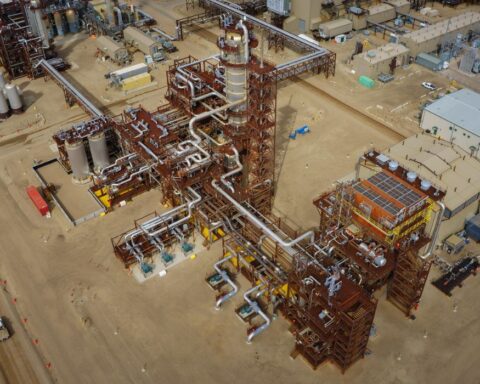Bring it on. That was the governing Liberals’ response to Conservative Party leader Pierre Poilievre’s call for the next Canadian election to be a “carbon tax election.” Both parties are suiting up for battle. Carbon pricing is embedded in the Liberal brand, and they are doubling down in their support for it, even as some question whether the policy has passed its “best before” date.
As for the Conservatives, they see a wedge issue they can stir up to their political benefit, and their “Axe the tax” slogan is tailor-made for riling up their base: it rhymes, it fits on a baseball cap, and it supports their “divide and conquer” strategy for electoral victory. Combined with the Liberals’ intransigence on the issue, the stage is set for a shouting match over the carbon tax at a time when we urgently need a grown-up conversation about how to address the climate emergency while securing Canada’s place in the emerging new-energy economy.
Canada is one of the most decentralized federations in the world, and achieving consensus on national policy is difficult at the best of times. In addition, unlike most of its OECD (Organisation for Economic Co-operation and Development) trading partners, revenue from oil and gas exports is important to the national economy and the economic lifeblood of the producing provinces. While the Supreme Court of Canada has ruled that the federal government has the constitutional right to put a price on carbon, it has proven a formidable political challenge to find a solution that responds to the climate emergency while reconciling the interests of producing and consuming provinces as well as the competing imperatives of short-term gain and long-term prosperity.
The result is the revenue-neutral, two-part federal carbon-pricing policy we have today: a carbon tax on fuel rebated to households and most of the economy, and an output-based regulatory pricing and trading system for emissions-intensive industries (the big polluters). Both systems share a common carbon price that increases to $170 per tonne by 2030 from its current level of $80 per tonne. Provinces and territories may opt in or out of either or both parts by substituting their own approach as long as they are consistent with the federal government’s carbon-pricing schedule. The result is a patchwork with four tax regimes and nine separate industrial pricing systems that could all come apart at the seams if national and provincial leaders keep turning up the heat.
The Canada Carbon Rebate — now you see it, now you don’t
The first part of our carbon-pricing system is the one most familiar to Canadians: a “tax and dividend” approach in which fuel distributors pay the carbon levy and pass it on to consumers. The revenue – about $8.3 billion in 2022/2023 – is returned to the provinces in which it is raised, mostly in the form of quarterly rebates that are based on the total carbon emissions of the province but not on the emissions of individual households. For most households, the rebate is larger than the tax paid, and the idea is to provide an incentive for them to reduce their carbon emissions so that they can continue to come out ahead as the carbon levy increases year by year.
Polling from Nanos indicates that nearly half of Canadians don’t believe that the carbon tax is effective, and as the people whose behaviour it is designed to influence, they should know. The impact that the tax has at the gas pump is less than the routine variation in gas prices to which Canadians have become accustomed. The impact on heating bills is more noticeable but not by itself sufficient to cover the capital costs of the deep retrofits and heat pump conversions needed to get the buildings off fossil fuels. Meanwhile, the government is faltering on public relations; indeed, a large portion of the population does not realize that the quarterly rebates are related to the carbon tax, and many do not even know they are receiving the rebates, which are mostly delivered via direct bank deposits. The government’s recent rebranding of what was previously called the “Climate Action Incentive Payment” as the “Canada Carbon Rebate” signals a renewed commitment to shoring up sagging support for carbon pricing.
Economists have oversold the effectiveness of carbon pricing in the real world.
Skepticism about the impact of the carbon tax is fuelled by assertions that it is the most efficient and effective way to reduce emissions, which fly in the face of common sense. Economists have oversold the effectiveness of carbon pricing in the real world, where fuel prices are a relatively small portion of the cost of services and amenities. Lower-income households feel its pinch more than others, but they are also in a weaker position to make the investments needed to reduce their energy use.
From building codes to vehicle fuel-efficiency standards, examples abound where rules and regulations win hands down over carbon or energy pricing in bringing about efficiency and emission reductions. In 1987, U.S. president Ronald Reagan was able to trigger a dramatic increase in refrigerator efficiency with a new set of appliance rules for the manufacturers. It boggles the mind to imagine just how much fuel tax it would have taken to raise the price of electricity high enough to achieve the same results.
Carbon pricing has been on the policy agenda since the 1980s, but in the last few years the technological pathway for decarbonizing buildings, transportation and electricity has come into sharper focus, and the urgency of addressing the climate emergency has increased. At worst, the Canada Carbon Rebate is an innocuous, zero-sum shell game. At best, a continuously rising carbon price will have a marginal direct effect on emissions while increasing the receptivity and success of the quicker, targeted and more direct measures that are needed now to address the climate emergency.
The biggest polluters pay the least
If you think the Canada Carbon Rebate is complicated, buckle up: there are hundreds of pages of rules and regulations governing the various federal and provincial systems for industrial carbon pricing.
In a nutshell, the second part of Canada’s “carbon tax” system works like this: Each facility covered by the federal output-based pricing system (OBPS) is permitted to freely emit greenhouse gases up to an annual limit. That limit depends on the facility’s emissions output and an emissions-intensity standard specific to the product being made in the facility, be that cement or steel, et cetera. If the facility’s emissions exceed this cap, then the company must either pay the carbon price on the additional emissions or submit what are called surplus allowances – effectively, credits it has banked from previous years when it didn’t exceed the cap or bought on the secondary market from other companies.
Still with me?
Those free emission allowances are adjusted to protect the viability and competitiveness of Canadian producers in global markets, so that, say, a steel company in Northern Ontario doesn’t drown in carbon taxes trying to compete with cheaper steel from abroad. It’s a system built for gaming, and a small army of consultants and lobbyists work hard at minimizing the costs that companies are paying for their emissions. Large emitters pay the carbon charge on only a portion of their actual emissions and so end up paying less for carbon than the average Canadian family. Suncor Energy, for instance, one of the largest oil companies in Canada, paid just $1.67 per tonne of greenhouse gases in 2020 when Canadian families were paying $30 per tonne. (Suncor estimates it will pay $8.97 per tonne between 2021 and 2030, less than a 10th of the $103 average price of carbon during this period.)
Large emitters end up paying less for carbon than the average Canadian family. Suncor Energy paid only $1.67 per tonne in 2020, when families paid $30.
Although transparency was a stated design objective of the OBPS, the carbon market that it spawned is a muddy swamp, causing headaches for regulators and uncertainty for investors. As Dave Sawyer, the Canada Climate Institute’s chief economist, notes, “It’s astounding that systems are not in place to track how these markets function and whether the market price holds.”
The rationale for granting these emission allowances to large emitters like pulp and paper mills is that they’re considered “trade exposed,” or at an unfair disadvantage in global markets against competitors that aren’t similarly taxed. This argument is stronger from some industries than others: in the case of steel or cement, paying a carbon tax of $50 per tonne doubles the costs of production, while in the case of oil extraction, it adds only a few dollars per barrel – enough to incentivize pollution reduction but not a competitiveness deal-breaker.
But the tide is turning now as the green transition moves forward, industrial processes evolve, and the European Union and the United States move to impose tariffs on carbon-intensive imports (so-called carbon border adjustment mechanisms). In other words, carbon pricing is coming for these industries, one way or another, and these industries need to decarbonize to survive. To be effective, the current output-based pricing system must be evenly applied across the country, driven by a carbon price aligned with international best practice, and integrated with other government initiatives for industrial decarbonization.
Ultimately, carbon pricing is a small component of the full suite of government spending, lending, and regulatory and tax instruments that are needed to effectively respond to the climate emergency while securing a place in the global low-carbon economy. The last thing the country needs is a “take no prisoners” battle to the death over the carbon tax that could set back what climate progress has been made. If the Liberals did an about-face on the retail portion of the tax while doubling down on the industrial pricing, it would lower the temperature on the climate conversation at a time when the world can’t afford any further warming.
Ralph Torrie is director of research at Corporate Knights.







